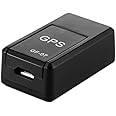Choosing between a real-time GPS tracker and a passive one can feel like navigating a minefield. Both offer location tracking, but their functionalities, applications, and ultimately, their value, differ significantly. This in-depth comparison will help you understand the nuances of each type, clarifying which option best suits your specific needs.
Understanding Real-Time GPS Trackers

Real-time GPS trackers, as the name suggests, provide continuous location updates. Think of it like having a live feed of the asset’s whereabouts. These trackers transmit location data at regular intervals (configurable by the user), typically ranging from a few seconds to several minutes. This constant stream of information is invaluable for various applications requiring immediate awareness of an asset’s position.
Key Features of Real-Time Trackers:
- Live Location Updates: The most significant advantage. You see the asset’s movement in real-time on a map interface.
- Immediate Alerts: Configure geofences (virtual boundaries) and receive instant notifications when the asset enters or exits these zones.
- Historical Data: While primarily focused on real-time tracking, most systems also store historical location data for later review.
- Two-Way Communication (Often): Some advanced real-time trackers allow for communication with the tracked asset, such as sending messages or activating a siren.
- Advanced Analytics: Data collected can be analyzed to provide insights into speed, mileage, stop times, and other relevant metrics.
Ideal Uses for Real-Time Trackers:
- Fleet Management: Monitor vehicle locations and optimize routes for efficiency.
- Asset Tracking: Keep tabs on valuable equipment, preventing theft or loss.
- Emergency Response: Quickly locate individuals or vehicles in emergency situations.
- Personal Safety: Provide peace of mind for loved ones, particularly children or the elderly.
Exploring Passive GPS Trackers

Passive GPS trackers, on the other hand, don’t transmit location data continuously. Instead, they record location data periodically and store it internally. This data is then downloaded or retrieved at a later time, often manually or via a scheduled data upload. They typically rely on a longer-lasting battery life due to their infrequent transmission.
Key Features of Passive Trackers:
- Extended Battery Life: The infrequent transmission significantly increases battery lifespan, sometimes lasting months or even years.
- Lower Cost: Generally less expensive than real-time trackers due to simpler technology and reduced data transmission costs.
- Data Retrieval Required: Requires physically retrieving the device or utilizing a data retrieval mechanism to access the recorded location information.
- Ideal for infrequent location checks: Suitable for situations where constant tracking isn’t crucial.
Ideal Uses for Passive Trackers:
- Long-Term Asset Monitoring: Tracking the general movement of an asset over an extended period.
- Hidden Asset Tracking: Discreetly track assets without the need for constant communication.
- Wildlife Tracking: Monitoring animal movements in remote locations.
- Logistics in Remote Areas: Tracking shipments or deliveries where cellular or satellite connectivity is unreliable.
Real-Time vs. Passive: The Ultimate Showdown

The “better” tracker depends entirely on your specific needs and priorities. Here’s a table summarizing the key differences:
| Feature | Real-Time Tracker | Passive Tracker |
|---|---|---|
| Data Transmission | Continuous, real-time | Periodic, batch upload |
| Battery Life | Shorter | Longer |
| Cost | Higher | Lower |
| Alerts | Immediate alerts possible | No real-time alerts |
| Applications | Fleet management, emergency response | Long-term asset monitoring, wildlife tracking |
Making the Right Choice

Before making your decision, ask yourself these critical questions:
- How often do I need location updates? If you require near-instantaneous information, real-time is the way to go. If infrequent checks suffice, passive might be suitable.
- What’s my budget? Real-time trackers typically come with higher upfront and ongoing costs.
- What’s the environment like? Will the tracker have reliable cellular or satellite connectivity? Passive trackers are better suited for areas with limited connectivity.
- What’s the level of security required? Real-time tracking offers more immediate responses to potential theft or unauthorized access.
By carefully considering these factors, you can confidently choose the GPS tracking solution that best meets your unique requirements, ensuring optimal performance and return on investment.
Remember to research different brands and models within each category to find the best fit for your specific needs and budget. Reading customer reviews can also provide valuable insights into the reliability and performance of various tracking solutions.


